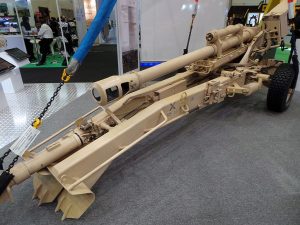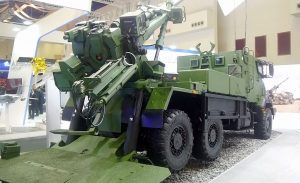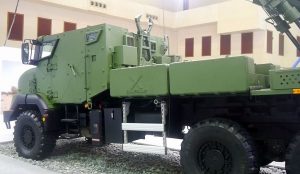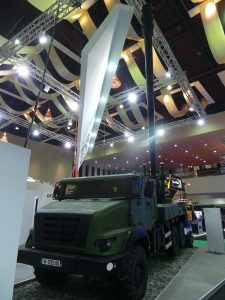KUALA LUMPUR: THE Nexter Systems Caesar 155mm truck-mounted self-propelled howitzer returns to Malaysia after some 20 year absence. This time around at DSA 2016, the Caesar 155m 52 calibre howitzer gun is mounted on the Renault Defense Sherpa 5 up-armoured truck.
Apart from the Caesar, Nexter Systems is also displaying its LG1 105mm light howitzer at DSA and its host of ammunition from 20mm shells to 155mm calibre rounds. The LG1 has a maximum firing range of 19 km with extended rounds. It could also be deployed using the Nuri and the EC725 helicopters.


Today Nexter Systems signed a Letter of Intent for collaboration with Advanced Defence Systems Sdn Bhd (ADS) to promote, assembled and maintain the Caesar in Malaysia.


If contracted with the Malaysian Army, ADS will set up a Caesar assembly and maintenance facility while Nexter Systems will provide the required technology and know how to assemble, integrate and maintain the Caesar SPH systems.


According to ADS chairman Datuk Abdul Hadi Abdul Razak their offer was for the Army to purchase 20 Caesar SPH, initially. 18 will be part of an artillery regiment while the other two will be used for training purposes.


He said depending on the Army’s requirements they could also offer fire-control solutions mounted on the same Renault truck. The Army could choose the un-armoured variant of the Sherpa 5. “It will depend on the requirements of the Army”.
Abdul Hadi, a former Kor Artileri Di Raja commander, was involved in the initial testing of the Caesar when it was brought to Malaysia back in 1995. He said the KAD had identified the need for a SPH regiment back then but until now the requirement have yet to be fulfilled.
According to Abdul Hadi unlike a tracked SPH, the Caesar’s low weight, less than 18 tons in combat configuration, reduces both complexity and cost. Its strategic, operational and tactical mobility is superior to that of other systems, while matching the reactivity of the self–propelled guns and the light weight of the towed guns.
He also said the Caesar could easily be integrated into the Army’s C3I infrastructure easily. Furthermore, he pointed out that the truck mounted SPH could self-deployed to anywhere in the peninsular within hours of being alerted.
The Caesar is also transportable by air on both RMAF air-lifters, the C130 Hercules and the Airbus A400M unlike tracked howitzers.
— Malaysian Defence
If you like this post, buy me an espresso. Paypal Payment
View Comments (19)
First it depends on money : ]
Then it depends on doctrine and operational requirements.
If we have a need for arty to keep pace with armoured or mobile formations over rough terrain; then a tracked based solution is the answer. If however armoured or mobile formations will not be moving rapidly across rough terrain but will be operating mainly in areas where there's are paved roads or in areas such as palm oil estates,etc; then the answer is a wheeled based solution. Wheeled or tracked? Each has its merits.
There is also the key question of what we foresee our arty doing in a future state on state conflict? During the 2nd Emergency we were lucky in that the bad guys had no arty. Arty spent most of its time in direct support of infantry units and the occasional fire harrasement mission following an engagement. In any future clash with non state actors [i.e. Lahad Dato], our arty would be doing the same but with state actors, arty would, in addition to providing direct or indirect support to units; would also be doing stuff like counter battery fire or deep penetration missions [on paper this is beast performed by MLRS however]. Slightly complicating matters is that the opposition will have the means to fire back at our arty and that targets will be shifting.
Then there is also the question of how much decentralisation and centralisation we need; i.e. brigades have operational control of artillery Regiments but control should be passed down to battalion level when there is a need [off course there are operational and logistical issues here]. The infantry battalions on their part should also increase the number of people trained to call in arty and the time it takes from the time a fire request is received, to the time rounds fall on target should be decreased.
No point having Arty Regiments under operational control of Brigades if the battalions being supported can't get their support on time. And no point getting new arty with ''range'' and ''firepower'' if we can't ''see'' targets or hit those targets on time, if infantry units don't train with arty units on a regular basis or if we don't have adequate stocks of ammo or we have adequate stocks of ammo but we can't get them to where they're needed in time ... In short there are so many factors to consider before we can even talk of how effective our arty will be.
Very easy solution. Since there are so many complucated issues we should not buy artillery at all
Azlan "If we have a need for arty to keep pace with armoured or mobile formations over rough terrain; then a tracked based solution is the answer. If however armoured or mobile formations will not be moving rapidly across rough terrain but will be operating mainly in areas where there’s are paved roads or in areas such as palm oil estates,etc; then the answer is a wheeled based solution."
Perhaps when it comes to 52 caliber artillery systems, the considerations are different from the tactical vehicles they are supporting. Because of their long range, they may be able to to keep to roads or firm ground and still keep the supported unit's frontage under cover.
Take the example of the wheeled HIMARS. It has been more popular recently than its predecessor the tracked M270, both in the US armed forces and in exports. Users have realised their environments have enough firm ground to strike the majority of targets. These vehicles can move around their territories more quickly, by land and air, eg by taking bridges that are unable to support the weight of tank-sized tracked vehicles.
In my limited experience, the decision between tracked and wheeled vehicles also involves the characteristics of these wheeled vehicles.
I have seen troop movements in very sodden ground. There were the standard prime mover trucks, medium trucks and light tactical vehicles (which in civilian terms would fit in the light truck category). All of these vehicles had 2 axles. But only one vehicle got stuck, the medium truck that was close to its maximum load AND the only one that lacked 4 wheel drive.
I wouldn't know about the ground pressures, weight and so on on the vehicles I saw. But I would think the 17 ton Caesar system on its 3 axle truck has a lower ground pressure than most military vehicles.
Caesar 155mm is nice, and personally I think the number of 155mm that we have is on the low side (even with the possible acquisition of Paladin).
But I think in the aftermath of LD incident, while the military literally bombed the intruder to pieces for more than 2 hours, I still think we need to improve upon our light artillery, which includes the 105mm howitzers and mortar. I think the LG1 light howitzers(and the M119) should be considered since it has twice the range of Oto melara pack gun, while 120mm mortar basically have roughly equivalent range as oto melara but with larger munition (almost as big as 155mm shell afaik)
Lee Yoke Meng "Very easy solution. Since there are so many complucated issues we should not buy artillery at all"
With so many different choices, I'm surprised you don't want to carefully study the best gun for our needs.
Buying whatever your heart feels like that you suggested in the past (JF-17, Chinooks, squad level mortars, armed to the teeth OPVs) is not the solution.
Academic aside...its time to equip what ever is ready n available for the men in green...when push comes to shoves we will even use ww2 pounder to aim at the general direction of the enemy n fire off crates after crates just for deterence n fear effect...even the tongkang will be armed to the teeth if ever uncle Sam decided not to kay poh in the SCS....wind of change will come when the new president come into power....my 2 cents
Lee - ''Since there are so many complicated issues we should not buy artillery at all''
Instead of making sarcastic comments [which anyone can do], why don't you share with us your opinions as to the changes that the Royal Artillery Corps needs to get on with the times.
Buying the gun is easy, getting the gun to perform to its best is the hard part.... involving ''complicated issues'' [to quote you] which call for deep thinking and innovativeness. BTW, as an ex serviceman, you of all people surely knows that everything; whether basic infantry skills, logistics or combined arms tactics; involves ''complicated issues''.
Alex - ''But I think in the aftermath of LD incident, while the military literally bombed the intruder to pieces for more than 2 hours''
First ask whether the arty strike actually made a difference to the final outcome and whether any Sulu gunmen were actually killed by a M1 HE round .....
Alex - '' I think the LG1 light howitzers(and the M119) should be considered since it has twice the range of Oto melara pack gun,''
Range is important but first we have to ensure we can hit what we aim at and that we can mass fire. The key is ''mass fire'' [not mass guns] whether fired indirectly or directly and whether the fire mission is observed or unobserved. History is full of armies who had guns with ''long range'' [which some are so enamored of]but couldn't take advantage of that ''long range'' because of various deficiencies.
AM - ''With so many different choices, I’m surprised you don’t want to carefully study the best gun for our needs.''
Yes. Instead of routinely falling back on ''sarcastic mode'' and giving the impression that ''long range'' and firepower'' is a panacea and more important than anything else; it would be more interesting if Lee would share with us his thoughts on how the Royal Artillery Corps can evolve to deal with future threats, i.e. what changes are required for doctrine, organisation, coordination with combat units, etc.
I would argue that in contrast to infantry and armoured units; the Royal Artillery Corps has much more catching up to do with regards to keeping up with the times - its doctrine and organisation hasn't changed much from the days of the 2nd Emergency; irrespective of the new gear it has acquired over the years. Before someone accuses me of neglecting the lessons learnt from the 2nd Emergency; I will point out that a lot of the lessons learnt are still valid but not all; given that times have changed and that the operational circumstances faced then were unique to that conflict.
Indeed there are ''complicated issues'' involved but then waging war is probably the hardest endeavour known to mankind and unfortunately; ''complicated'' stuff like doctrine and organisation [to name a few] determines how effectively armies perform. If only, how effective artillery units will perform is a simple as the type of gun we acquire and the maximum range it has .....
If you are to ask me, the artillery is easily the queen of the battle field. Let us ask ourselves. What wins a war?. It depends on the strategy adopted. One is disregard technology n go for massed human warfare versus massed technology superiority. This technique was adopted by the chinese n vietnamese in their strategy. But time changes. Even china has to cut down the size of its army by 300,000 troops n go for tactics n technology to win wars.
If we look at history of the korean war, both sides used massed firepower both before an attack n during an attack to pin down n break up the attack. So artlillery is both a weapon of attack n defence. The bombardment need not kill a lot of soldiers. All they need is to stun the defenders n make them disorientated during the advance to contact phase. This will give the attackers time to close up with the enemy.
On the defensive side, the artillery can be used to attack during the massing of troop phase to break up the massing. This will either stop the attack or reduce the weight of the assault.
So what do we need in the artillery?. On the strategic side our investments in the rockets is a good decision. However, our unguided rockets cannot hit with precision. We need to buy the gps guided version when it comes out. This will add accuracy to attack high value targets.
On the gun side, we need to add to our short range/light artillery system. The Italian pack howitzer system we have is outgunned at present due to its short barrel n short range. Modern light guns can easily outrange this pack howitzer. However, its the only gun that can be disassembled n carried by bombardiers into hard to reach areas. Forget the shield. However in modern warfare n with artillery n mortar tracking radars this is rather hard to do shoot n scoot. So mostly our current light guns are all within range of any enemy's light guns. Range is thus important for self preservation n for mobility especially when undertaking urgent max range fire support. To cover a certain length of front, we need guns with good range as compared to guns with shorter ranges. For effective fire support we also require these guns to fire in a battery level n not single guns like in the emergency days.
In an artillery battle, guns with a shorter range will always need to move after firing but no matter where they move to, they must move to a place where they can reach the target for the next shot. Thus it must move in a semi circle. Whereas the guns with a longer range just wait n all they need to do is wait for the next shot n they can turn their aim to fire for effect.
Some have said no need to have fire power n no need to have range. Range n fire power is just rubbish. But let me say this. Range n firepower equates to survival of our men.
Artillery battalions have trained FOO' embedded with the front line n special observers are available to spot n correct fire. These are brave people as they often goes with recce patrols into enemy territory to pre register targets .
Many says its pointless to have firepower in the infantry as they need to carry plenty of amno. Thats why we train the infantry to do. Look at a modern battlefield. In Afghanistan the us infantry section of 8 men carry 4 saw's. They too need to dismount n fight especially in the green zone. Looking back at both the emergency n confrontation, in an ambush the enemy always make sure that they have an advantage n a heavy volume of firepower.
In the infantry, the first stage of combat is calked "winning the fire fight". What is winning the firefight?. It is whichever side can pin down the oppossing side by sheer weight of firepower. If we cant run the firefight we are gone. Reason is we cant move. Cant even withdraw but just lie down n get hammered. The only way to allow for counter attack is to win the fire fight. Pin the enemy down instead. Of course, a brave charge that would win a pgb or two would also be great but can we accept the casualties?. Remember that the lives of our men are in our hands. We dont want widows n single parent kids as far as possible. So equipping our sections with 2 saws is great as compared to one only now. Light mortars n grenade launchers are great in open areas but in a closed environment may not be practical.
So coming back to arty, we need both towed n self propelled arti in the 155mm class for long range. Buy the 52 caliber guns that has longer ranges. Then buy more modern 105 light guns. These are light guns n can be towed. We need a combination of both tracked n wheeled guns. Having just wheeled guns make our options for firing more limited n the enemy can guess or use recce means to concentrate in certain areas to locate our guns. If we have both the options become wider n more difficult to guess or need to expend more time to cover all posdibilities. Range n firepower is the winning formula. Just ask any serving officer or men
1) more firepower.
This is addressed by the army by having fire support company in every battalion. They are equipped with 81mm mortars and 0.50cal machine guns.
More firepower is also now available within the infantry section, with 2 rpg and 1 mgl to add to the single saw.
155mm is more towards supporting the movement of large formations, and here also the army is moving towards the right direction in adding sph to its inventory. So it is not like the army didn't plan to add more 155mm's.
2) precision strike.
This is a good thing to have, but not really necessary for the artillery regiment. Precision strike can be done by air (lgb bombs, missiles) for long range and from land (igwe missiles, metis m etc)
By the way, lets move forward and acknowledge the things the army is doing that supports your ideal (like more firepower, which they are doing), and discuss what other methods that the army could improve on, and suggest how they can do it (in a practical, achievable way of course)